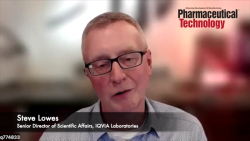
OR WAIT null SECS
- About Us
- Advertise
- Contact Us
- Editorial Info
- Editorial Advisory Board
- Do Not Sell My Personal Information
- Privacy Policy
- Terms and Conditions
© 2025 MJH Life Sciences™ , Pharmaceutical Technology - Pharma News and Development Insights. All rights reserved.
Chalmers Researchers Develop Fluorescence Method to Track RNA
Chalmers University researchers have developed a method to label and track mRNA molecules.
Researchers at Chalmers University of Technology, Sweden, announced on June 30, 2021 that they have succeeded in developing a fluorescence method to label messenger RNA (mRNA) molecules, allowing them to track, in real time, the path of the mRNA molecules through cells with the use of a microscope while not affecting the molecules’ properties or subsequent activity. The breakthrough could be of great importance in facilitating the development of new RNA-based medicines, according to a university press release.
While RNA-based therapeutics offer a range of new opportunities to prevent, treat, and potentially cure diseases, the delivery of such therapeutics into the cell is currently inefficient. Therefore, for new therapeutics to fulfill their potential, the delivery methods need to be optimized.
The research behind the RNA tracking method developed by Chalmers researchers was conducted in collaboration with chemists and biologists at Chalmers and AstraZeneca via their joint research center, FoRmulaEx, as well as a research group at the Pasteur Institute, Paris, France. The method involves replacing one of the RNA building blocks with a fluorescent variant, which, apart from that feature, maintains the natural properties of the original base. The fluorescent units were developed with the help of a special chemistry technique (?), and the researchers have shown that it can be used to produce mRNA without affecting the mRNA’s ability to be translated into a protein at natural speed.
The method represents a breakthrough that has not been done successfully before, according to the press release. The fluorescence furthermore allows researchers to follow functional mRNA molecules in real time with a microscope and observe how they are taken up into cells.
mRNA molecules are challenging to work with because of their large size and the fact that they are charged and, at the same time, fragile. They cannot enter cells directly and must be packaged. The method for mRNA uptake that has proven most successful to date uses lipid nanoparticles to encapsulate the mRNA. However, there still exists the need to develop new and more efficient lipid nanoparticles, which the Chalmers researchers are also working on. The ability to monitor, in real time, how lipid nanoparticles and mRNA are distributed through the cell is an important tool.
"Since our method can help solve one of the biggest problems for drug discovery and development, we see that this research can facilitate a paradigm shift from traditional drugs to RNA-based therapeutics," said Marcus Wilhelmsson, professor at the Department of Chemistry and Chemical Engineering at Chalmers University of Technology, in the press release.
“The great benefit of this method is that we can now easily see where in the cell the delivered mRNA goes, and in which cells the protein is formed, without losing RNA's natural protein-translating ability,” said Elin Esbjörner, associate professor at the Department for Biology and Biotechnology, Chalmers University of Technology, in the press release.
Researchers working in the area of RNA studies can use this fluorescent tracking method to gain greater knowledge of how the uptake process works, which can accelerate and streamline (?) the discovery process for new therapeutics.
“Until now, it has not been possible to measure the natural rate and efficiency with which RNA acts in the cell. This means that you get the wrong answers to the questions you ask when trying to develop a new drug. For example, if you want an answer to what rate a process takes place at, and your method gives you an answer that is a fifth of the correct, drug discovery becomes difficult,” explained Wilhelmsson in the press release.



